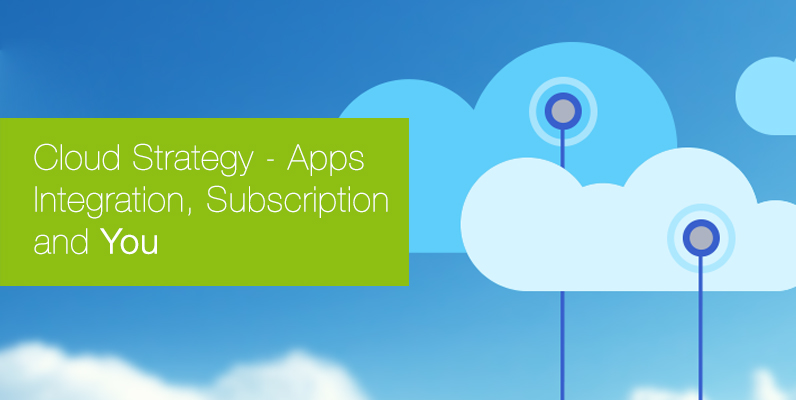Since Cloud computing has made big leaps in the past few years by emerging as a conventional business tool, several strategies have consequently surfaced. These myths aren’t necessarily as risky as they were initially presented to be, but they certainly affect our methods of approaching solutions in the Cloud computing space.
The following is a list of some of the notes that you will find useful while :
1. Understanding Cloud, Subscriptions – Cost savings:
Many consider that Cloud is all about saving money. In fact, that is the number one reason why companies are migrating to cloud. However, the truth is that saving money isn’t the most important benefit of switching to the cloud. The real advantage lies in the agility that Cloud offers. Though the prices for IaaS (Infrastructure as a Service) are dropping, most Cloud App pricing has remained fairly consistent. This is not quite true for SaaS (Software as a Service) or PaaS (Platform as a Service) where we are actually seeing some increases – so the earlier you get in and lock your price, the better you are in the long run.
Money through Cloud can be saved only after doing an exhaustive analysis of the situation where the total cost of ownership can be determined. To get a sense of the full picture, one must look beyond just upfront costs and also be certain about the significance of the shift from capex (capital expenditure) to opex (operational expenditure). Capex or front loading software expense has been the main money maker for software giants with the likes Microsoft, Oracle or SAP. This was challenged with the likes of Salesforce and Amazon and their subscription models to change the paradigm, and they have succeeded in doing so. Now subscription software has become the main method of sales across the board. So like it or not, your software is likely going to steer you towards subscription pricing sooner or later.
2. The new model for Software delivery
Cloud and subscription-based pricing have intertwined over the years. An on-premise software sold on subscription pricing is also at times called “Cloud App” and has become common practice. Many organizations intentionally or unintentionally have been “Cloud washing”: A general tendency to call things cloud which actually aren’t. Let’s say for example Adobe’s popular Illustrator and Photoshop suite of products. They are licensed on a subscription model but you still have to install and run on your machine. Reading the headlines of popular publications could leave a business owner with the impression that Cloud is a such a mandatory aspect of the business that business goals cannot be achieved without it. This notion can be debated. Some Cloud vendors believe that connecting everything with Cloud makes them look more important, sophisticated and at par with the current IT trends, perhaps get more funding or help in the market themselves, but the fact is that all of these often construe the true essence on being on the Cloud.
Cloud Apps certainly helps in massive scalability and reliability of running your operations without the overhead that you would have for traditional on-premise software. This is especially true for Cloud Apps and not necessary with IaaS – like hosting and managing your servers on the cloud. You still might have “some” of the operational overhead (minus) hardware cost. There are many scenarios when a Cloud app or service might not make sense. Say for example your firm is generating massive amounts of data or sensitive healthcare data within your in-house systems. The cost of sifting through this data back and forth to the Cloud service might be cost and time prohibitive. Perhaps you should see a hybrid approach leveraging best of both worlds.
3. Integrated Best of Breed Cloud apps
Cloud computing is not just “one thing”. Because of the complexity of Cloud computing, a cloud strategy should be formed. There are several Cloud services in the market spanning on multiple levels, models, scopes, and applications. Some leading Apps, for example, are Salesforce (CRM), QuickBooks (Accounting), Dropbox (Storage). For infrastructure, Amazon Web Services and Azure are leading the way.
Before building a cloud strategy, it is important to figure out and align the business goals with its potential benefits. According to these benefits, the necessary operations should be decided and these may involve multiple cloud services. Considering these operations, a single cloud strategy can be formed based on a decision framework that allows these multiple services to function at full efficiency.
Cloud service providers have increasingly started to collaborate with others, bringing together best of the breed apps together. You can find marketplaces like AppExchange (Salesforce) or Amazon Web Services Marketplace, which bring together many apps to function seamlessly with their platforms. For others where there are gaps, there are Integration vendors like DBSync or Informatica than through their iPaaS (Integration platform as a Service) fill the gap.
4. Cloud Security and Risks
One of the number one concerns I hear from business owners when faced with switching to the Cloud is that cloud computing is less secure and could put their organization at risk. The reality is that many security breaches start from the on-premise data center environments and not on the public Cloud. This is because the Cloud providers make significant investments in security technology specifically because this is so many businesses primary concern.
Even so, you cannot assume that Cloud is entirely free from all kinds of security risks.
Security does not depend on one factor and it is very important to identify where the security vulnerabilities actually lie. It’s better to always err on the side of caution in order to avoid a security breach. This is possible when an organization assesses the actual capabilities of its potential Cloud service provider’s and takes the necessary security precautions accordingly.
5. Migrating to the Cloud
Many assume by simply migrating to Cloud that they will automatically be able to have all features and capabilities they’ve heard Cloud can do. This isn’t the case as a lot of the attributes and characteristics of Clouds aren’t transitive and depend on the infrastructure and setup of the business as well as what applications the business will be using. Applications hosted on the cloud are different from cloud services. You need to understand the difference. If an application is hosted in the cloud, it may not necessarily be a Cloud service.
As you can see, there are many misconceptions when it comes to adopting Cloud strategy. It’s very easy to read a few headlines or hear a few quick blurbs from the media and have a completely warped view of what switching to Cloud entails. The key when making a decision to migrate is education. It’s important for business owners and decision makers within an organization to take the time to learn as much as they can before pulling the trigger and switching to Cloud. Only when you have all of the information and truly understand it all can you decide whether or not it is the right move for your business.



